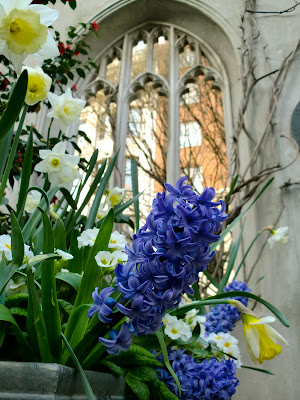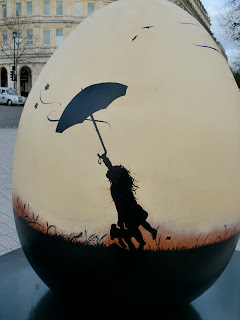All Hallows by the Tower is the oldest church in the city of London, having been founded in AD 675 by St. Ethelburga (great name!). The church has been expanded and rebuilt a lot over it's long history, and it has a lot of very old morbid connections because it is located so near to The Tower of London (which was a the Royal residence and execution ground for hundreds of years). It even has some really cool American connections: William Penn, founder of Pennsylvania, was baptized here in 1644, and John Quincy Adams, 6th President of the United States, Married his wife Louisa here in 1797.
During The great Fire of London, All Hallows was directly in the path of the massive blaze, but thanks to the quick thinking of our friend Samuel Pepys the church was saved. Pepys and some friends destroyed a bunch of buildings near the church so that the flames couldn't reach it. Sadly though, the German air raids of World War II caused extensive damage. Much of the structure of the church you see now is a result of painstaking restoration. One positive though is that the bombing unearthed a tiny chapel (or crypt) under the church that was previously hidden. The wall pictured to the right is from the original church built in the time of St. Ethelburga, and is one of the oldest man made structures in the entire city. It's called St. Francis's Chancel. I went down there thinking I was sure to get kicked out, but no, there was a sign inviting people to pray and find peace in the cool quiet. Being down there you truly feel like you've stepped back in time. All the sound from the modern world is hushed to a soft whooshing like a far away ocean. I found myself walking lightly as though the sound of my footsteps would disturb the profound silence of the room. I can see how this tiny chapel would have provided a solemn place of unadorned worship.
This church is really easy to miss (as you can see from the above picture). I was actually on my way to a different church when this one caught me off guard. It was named for a martyr, Clement, who is a patron saint of sailors, making this a once popular church for merchant sailors to attend. The name Eastcheap denotes it's location; "cheap" or "chepe" derives from the old Saxon word for market. Though there are clues dating the church back to the first century, the oldest recorded mention of the church is from AD 1207 (just after the founding of Huntingdon!). This church also claims to be the same St. Clemets from the old English nursery rhyme "Oranges and Lemons."
 St. Clement was one of the first Churches to be destroyed in the Great Fire. The church standing now was designed and built by Sir Christopher Wren, probably the most famous architect ever. After the Great Fire, he designed and rebuilt scores of buildings around London. The most impressive feature of this church is the impressive hand carved pieces, like the font cover of a caged dove, the ceiling details, the altarpiece (also called a reredos), and the gorgeous organ case. The thing I like most about this church is it's simple elegance. I sat in a pew and was able to appreciate the beautiful details with out being overwhelmed by kitsch.
St. Clement was one of the first Churches to be destroyed in the Great Fire. The church standing now was designed and built by Sir Christopher Wren, probably the most famous architect ever. After the Great Fire, he designed and rebuilt scores of buildings around London. The most impressive feature of this church is the impressive hand carved pieces, like the font cover of a caged dove, the ceiling details, the altarpiece (also called a reredos), and the gorgeous organ case. The thing I like most about this church is it's simple elegance. I sat in a pew and was able to appreciate the beautiful details with out being overwhelmed by kitsch.
St. Mary Woolnoth
St. Mary Woolnoth is a gorgeous and historically exciting church to visit. "Woolnoth" is believed to be a reference to a 12th century benefactor of the church, Wulnoth de Walebrok, and its full name is St. Mary Woolnoth of the Nativity. Usually it's the inside of these churches that is aesthetically pleasing, but the front facade of this church is (I think) equally stunning. Though this site has been used as a place for pagan and Christian worship for 2,000 years, the current building was commissioned in 1711 by a parliamentary act calling for the building of fifty new churches in London surrounding suburbs, and it is one of only six churches in London built by famous British architect Nicholas Hawksmoor. His striking design takes full advantage of the uniquely unobstructed location. Most churches in London suffer from being smothered by shops and office blocks, but after the Great Fire many of the buildings surrounding St. Mary's were demolished... and I think it's for the better. Personally I find the location to be a nice pause in a sea of drab, characterless banks and offices.
The inside of this church is an English Baroque medley. I know I'm getting all "art student" with my terminology, so in leiu of definition, I'll just point out some of the design characteristics present at St. Mary's. The sanctuary is flooded with natural light, which makes the space feel airy and learned. The dark wood and stone of the pews and altar are offset by the brilliant white corinthian columns and and detailed plasterwork ceiling. It's as though the room reflects Christianity, with the dark sinful world being illuminated by heaven above. It's really a visual and intellectual feast!
I also got quite a treat when, upon remembering my Evangelical history, I went in search of some reference to John Newton or William Wilberforce (both of whom worshipped here). There on the wall was a large marble memorial to Newton, who had been rector of St. Mary Woolnoth, and is buried in the church's vault. Newton, a former slave trader, became an abolitionist . He was famous in his anti-slaver sermons and also for penning hymns such as "Amazing Grace." He wrote his memorial himself:
John NewtonClerk.Once an infidel and libertine, a servant of slaves in Africa, was, by the rich mercy of our Lord and Savior Jesus Christ, preserved, restored, pardoned, and appointed to preach the faith he had long laboured to destroy.
St. Olave Hart Street
It has been described as a "country church," owing to it's size (one of the smallest in London) and the fact that it is one of the only medieval churches to survive the Great Fire. St. Olave dates back to the 13th century and is named for the patron saint of Norway, King Olaf II. Turns out King Olaf's army fought invading Danes way back in the day. This church (as well as a few others) was named for him by the some very appreciative Anglo-Saxons. The connections to Norway don't stop there either. During WWII, exiled King Haakon VI worshipped here until the end of the war. Another famous parish member, Samuel Pepys (this guy gets around!), worshipped here because it was across the street form The Admiralty, where he worked. There is a big marble memorial to him on one of the walls. Despite all the prestigious connections, the thing I like about this church the most is it's intimate atmosphere. You actually feel as though you could be in an old gothic church out in the countryside. It has a beautifully coffered ceiling, some not-overwhelming stained glass windows, and it even has brass sword rests attached to the end of each pew. Above the gate leading in to the tiny graveyard is a group of grinning skulls... appropriate considering the first plague victim, Mary Ramsay, is buried there. It was so unique that author Charles Dickens used it as the basis for a fictional church, St. Ghastly Grim.
St. Margaret Pattens

St. Margaret Pattens is another church that takes it's cues from English Baroque style (though to a much more understated effect than St. Mary Woolnoth). It is dedicated to St. Mary of Antioch, and pattens refers to a type of shoe. Worshipers at St. Margaret Pattens had to remove their shoes upon entering the sanctuary. The original church (probably a wooden structure) was first recorded in 1067. A stone building was erected in the 1500s, but it was destroyed in the Great Fire. The present church was built in 1687 by Sir Christopher Wren. The 200ft high medieval style spire of the steeple, was a bit of a throwback for Wren, and is exceptionally eye catching as it sits among modern office blocks.
St. Dunstan's is probably a case of saving the best for last. It's situated on Dunstan Hill half way between Tower Hill and London bridge, so it really is in the heart of London. Considering that, it's amazingly shielded from the hustle and bustle of the mega city by a sort of courtyard created by several tall (and very lucky) office buildings. I say lucky because St. Dunstan's is a treasure of calm and quiet. The original church, built in 1100 and dedicated to an English Bishop, was severely damaged in the Great Fire, but instead of rebuilding it, it was patched up and kept mostly intact. Sir Christopher Wren oversaw the repairs, and made improvements such as the gorgeous steeple which is of gothic design, keeping in style with the rest of the church. But Wren gave it a bit of a twist. The steeple's needle spire is held up by four flying buttresses. Also among the churches renovations were carvings and sculptures by Grinling Gibbons, famous English sculptor. His work can be seen in major churches and cathedrals all over England, including St. Paul's Cathedral and Westminster Abbey. St. Dunstan's must have been pretty special to attract the likes of Gibbons and Wren.
Sadly though, during WWII, a German bomb completely gutted the building. The walls and steeple were still standing but the roof and painstakingly restored interior were ruined. Instead of being demolished the church was turned in to a public garden. I think this may be my favorite place in all of London. It's perfect slice of heaven and it feels like not a single person in the City aware of it's existence. The urban garden is innovative in it's low-tech approach and includes an insect hotel to attract garden friendly bugs. Some of the modern stone work has been sensitively incorporated to enhance the space with out detracting from the beautiful medieval ruins. It's walled in on almost all sides by glass and cement office blocks, which aid in shutting out noise, and also hide it from passers by. You really have to know what you're looking for in order to find it, or otherwise happen upon it by total accident (like the room or requirement in Harry Potter). What I find most beautiful about St. Dunstan's is the metamorphosis the church has undergone over it's 900 year existence. Where there were once pews, now there is grass, trees and park benches. I can't imagine a more perfect oasis from this often overwhelming City.
Well that's it for now on London Churches. I hope to visit many more before I return to the US. I don't think I could possibly get through all of them, but who knows, maybe I'll pack some Red Bull and get an early start one of these days. I can't wait to explore more of London's churches. Whether they are grand and lofty, or small and quaint, even if they can hardly be called churches anymore from the damage they've suffered, I truly think they are all treasures.
Love you!
~Auntie~





.JPG)


























































